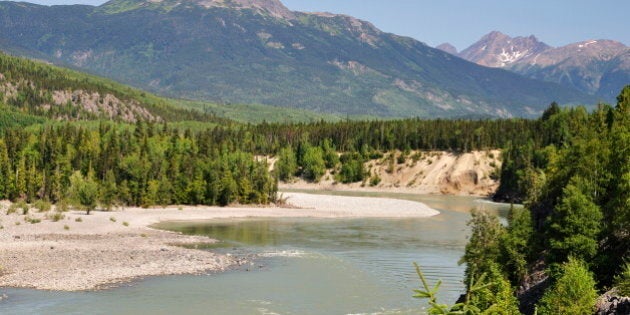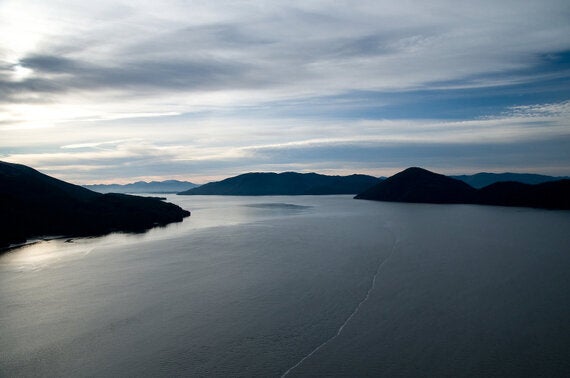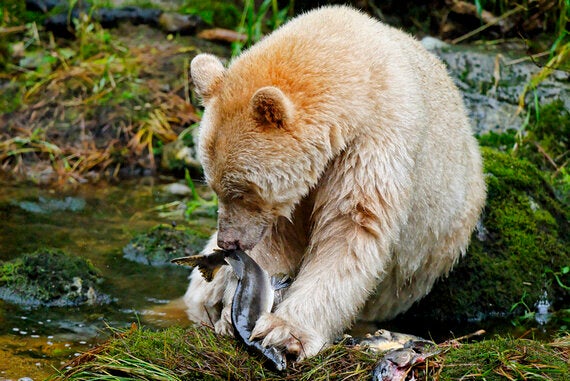
By James Casey, freshwater conservation speciallist
With one-fifth of the world's freshwater, Canada is a treasure trove of rivers, lakes and wetlands supporting countless communities, economies and species. This wealth of water is also a responsibility for Canadians to maintain. With freshwater species experiencing the greatest rate of decline in what is being referred to as the sixth great extinction, Canada must step up efforts to improve watershed health for people and animals.
For a prime example of our freshwater health and wealth, we need to look no further than the Skeena watershed on the northwest coast of British Columbia.

An aerial view of the Skeena River, British Columbia, Canada. © WWF-Canada / Chad Graham
Growing up in the community of Terrace, B.C., located in the Skeena watershed, I took so much for granted. I never understood that not every teenage boy has the chance to come across grizzly bears, black bears, moose and mountain goats as part of their weekend outings with family and friends. It took some time for me to realize that the coastal habitats of B.C. stand out as one of the few remaining places on the planet where excessive industrial development has not undermined the ecological functions of a region.
While the wildness of this place is unquestionable, and is perhaps most sensed when you have the opportunity and luck to spy a spirit bear, it is not untouched. This rich ecosystem also supports a rich economy that includes fisheries and tourism. These sustainable economies have been developed with natural limits in mind and, as a result, have made this a place where prosperity is achieved through an alternative approach.

Kermode, or spirit bear (Ursus americanus Kermodei), feeding on salmon, Princess Royal Island, British Columbia, Canada. © naturepl.com / Eric Baccega / WWF
Both the Great Bear Agreement and the recently announced Marine Planning Partnership agreement are world-class examples of ecosystem-based management that ensures economic opportunities do not compromise the ecological health of a region. These two agreements in particular show amazing progress towards making B.C.'s north coast a region where sustainable economic development strives to achieve ecological and cultural richness as the highest objective.
Unfortunately, unlike the marine and coastal parts of the region, the Skeena watershed does not have an overarching watershed plan that aims to maintain the ecological and cultural richness of the area.
Last month, WWF-Canada released a Canada-wide assessment of watersheds and, as expected, the Skeena watershed was among the brightest stars of the story. However, the assessment also reveals that the Skeena is experiencing moderate stress from fragmentation of streams by roads and pipelines. WWF's more detailed Skeena Cumulative Effects assessment is also starting to indicate the coming pressures from proposed industrial development related to sectors such as oil and gas. So, while the Skeena watershed is in very good ecological condition, the challenge is: what can we do to keep it that way?
With this information in hand and research still coming in, WWF-Canada is advocating for actions to protect the Skeena River estuary, including Flora Banks, the largest eelgrass bed in this region. Our hope is that the values of ecological and cultural richness found in the Marine Planning Partnership agreement will, with time, be reflected in the plans that guide activities throughout the Skeena watershed. As in the marine parts of the Great Bear, WWF will seek opportunities to see these values fulfilled throughout the Skeena watershed so that the sense of awe and responsibility that comes from watching a spirit bear fish a brimming salmon stream will be a message for generations to come.
Help support WWF's work on B.C.'s north coast for people and species. Become a monthly donor today and receive a special spirit bear adoption kit.
MORE ON HUFFPOST: